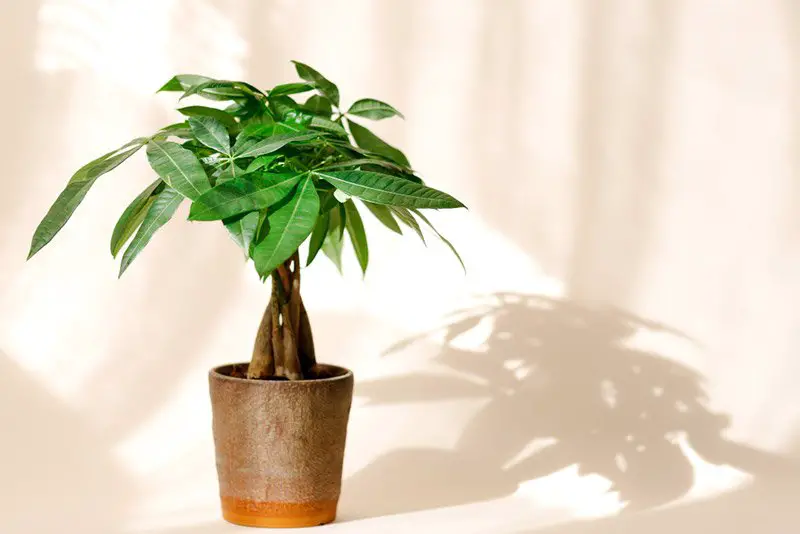How To Braid A Money Tree (When And Why You Should Do This!)
If you’ve ever wanted to level up your houseplant collection, then braiding a money tree might be the perfect solution for you.
Not only does this special braid give your money trees, or Pachira aquatica—also known as Guiana Chestnut trees, an eye-catching look, it also helps promote overall plant health.
Some people also think braiding a money tree offers the added bonus benefits such as increased luck, wealth and prosperity – which you supposedly don’t get from an unbraided money tree.
Below we’ll walk you through the process of how to braid a money tree, when you should consider doing so, and why it’s beneficial for both you and your plants!
So read on if you’re looking for ways to kick up the style with some extra green in your living space.
Do Money Trees Braid Themselves?

Since you’ve seen braided money trees, it’s natural for you to assume that this is something that these houseplants just do on their own at some point.
But you’d be wrong.
No, money trees do not braid themselves.
The trees are often grown in nurseries with multiple trunks, and as they grow, they are trained to braid together.
This process is similar to the way bonsai trees are trained, and it can take several years for the trunks to fully braid together.
To achieve a braided money tree, multiple trunks are planted closely together and then the trunks are twisted and woven together as they grow.
This process can take several years to achieve, depending on the growth rate of the tree.
What you may not know is that you can braid any type of tree or houseplant that has pliable stems, like Ficus, Hibiscus, Bay Leaf, and Azalea plants.
Reasons Why To Braid Money Trees
Not sure if braiding is the right choice for you?
Here’s a look at a few popular reasons for giving your plants this makeover.

It’s Symbolic + A Cultural Thing
In traditional Chinese and Japanese culture, money trees are believed to bring good luck and prosperity.
The braided trunk is thought to symbolize the coming together of different elements to create something strong and stable, much like how different strands of rope are braided together to make a stronger cord.
Braiding money trees was really thought to increase their energy – similar to the concept of chi – and it was believed that if the trunks were braided into a certain number of knots, different kinds of luck could be invited into one’s life.
In some cultures, Chinese citizens included, braiding the Pachira Aquatica represented the enrichment of friendship between parties; three stalks entwined together symbolized an everlasting bond among friends.
Gives The Plant Stability
The braiding of money trees also serves a practical purpose for growers and gardners.
You see, when money trees are grown in nurseries, they are often grown with multiple trunks.
And the act of braiding the trunks together actually helps to keep the tree stable and upright as it grows.
This is particularly useful for smaller trees that may not have a strong enough root system to support multiple trunks.
You’ll also want to braid your money trees if you intend on attempting to grow a particular tall tree, otherwise its unbraided trunk won’t be stable enough to support the tree.
Control Of Plant Shape
If you are very particular about how your money tree looks in terms of its lushness, then braiding it is a great way to get that control.
You’ll find that braiding the trunks of a money tree helps you control its growth and shape, making it easier to maintain and care for the plant.
It can also give the tree a much fuller appearance – especially if you are growing a big one.
In fact, many home gardeners will put several money trees in a single pot so that it really looks like a full and lush houseplant.
Do You Have To Braid A Money Tree?

If you’re still not sold on braiding your money tree, then you may be curious if this is really something that you need to do.
No, you do not have to braid a money tree.
The tree can be grown in a non-braided form, with a single trunk or multiple trunks that are not braided together.
This is known as a regular money tree, and it can be just as beautiful and vibrant as a braided tree.
However, do remember that if it grows too tall, then the trunk may not be strong enough to support the weight.
Of course, you have got to know what you’re doing because the braiding can be harmful to the tree if not done properly or if the tree is not mature enough.
The braided trunks can put a lot of stress on the tree and can cause damage to the bark, which can lead to disease and insect infestations.
If you decide to braid your money tree, make sure you monitor the tree’s health and to make sure it is not being harmed by the braiding process.
Steps To Braid A Money Tree
If you’re ready to take the plunge and braid your money tree, then we’ve got the easy steps for you to follow below.
Step 1: Choose the right tree at the right time.
The best time to braid a money tree is when the tree is a young sapling and its trunks are still relatively flexible.
If the trunks are too thick or woody, they may not braid together easily, and the process may cause damage to the tree.
Step 2: Plan the braid.
Before you start braiding, take a moment to plan out the braid.
You’ll want to make sure that the trunks are evenly spaced and that the braid will be symmetrical.
And you want to make sure that you have chosen a pot that is large enough to house all the tree stems.
And, we recommend a container with a drainage hole so that too much water doesn’t accumulate and cause root rot.
You’ll also want to choose a soil that is ideal for money trees, particularly a well-draining soil because these plants don’t like too much water.
Step 3: Begin the braid.
Start at the base of the trunks and begin to braid them together, making sure to keep the trunks evenly spaced and the braid symmetrical.
You’ll want to keep the braiding loose when you start out weaving the trunks.
This is because they will naturally tighten as the trees grow over time.
Step 4: Secure the braid.
Use soft and stretchable material such as soft cloth or stretchy rope to secure the braid in place.
Just don’t secure it too tight.
You should be able to remove that from the plant in about six weeks.
Step 5: Monitor the tree’s health.
After the braid is secure, keep a close eye on the tree’s health. If you notice any signs of stress or damage, loosen the braid and give the tree some room to grow.
It’s important to note that braiding a money tree can be a time-consuming and delicate process – so make sure that you have enough time to dedicate to the process the first time that you do this.